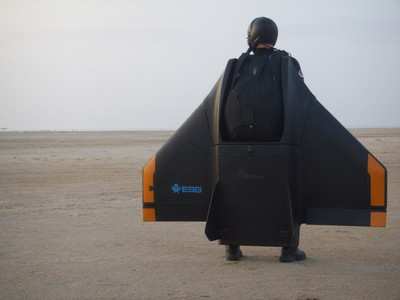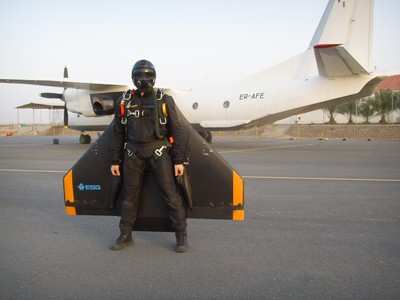Sun, May 04, 2008
Can Travel 125 Miles From 30,000 Feet... At 135 MPH
Don't confuse the next item with the opening of the film "Iron
Man" this weekend -- this is the real deal. It may not outrun a
Raptor... but its agility and stealth could revolutionize skydiving
as a sport, and eventually see its way to combat.

The Gryphon attack glider designed by SPELCO GbR weighs only 30
pounds and has a 6-foot swept-wing that is steered with handheld
rotary controls connected to its rudder. It can be fully weaponized
for assault and hide more than 100 pounds of combat gear in a
built-in compartment.
Designed to penetrate combat zones at 135 miles per hour, the
Gryphon is maneuverable enough to fly through the legs of Paris'
Eiffel Tower at high speed, as demonstrated through a simulation to
FOX News recently. The wing separates from the pack before the
parachute is deployed and remains connected via a cord, allowing it
to land before the pilot.
SPELCO hopes to offer the Gryphon to armed forces as a solution
to high altitude, high opening (HAHO) missions. Currently such
missions require jumps close to combat zones since traditional
parachutes only travel around 30 miles from the drop point to the
landing zone.
Future plans by SPELCO for the Gryphon include incorporation of
a small turbojet like those used for Unmanned Aerial Vehicle (UAV)
propulsion. Such an addition would eliminate the need to exit at a
high altitude to cover large distances... or, give soldiers added
time, and distance.
With its 5.1 glide ratio and on-board oxygen
system, a jet-powered Gryphon could allow soldiers to
exit up to 125 miles away from the landing zone at an altitude of
30,000 feet, far away from high-risk combat zones. The speed of the
Gryphon reduces the time of descent to from the typical 45 minutes
of a current HAHO mission to only 15 minutes -- significantly
reducing exposure to extreme cold at altitude, and possibility of
detection.

The compact design of the Gryphon with all equipment contained
within the lifting body gives the unit a very small radar
signature, making it an obvious choice for stealth missions.
More News
Pilot Applied Full Aft Stick And Nose-Up Trim, But The Airplane Remained On The Runway Analysis: The pilot reported that a preflight inspection and flight control checks revealed n>[...]
A Few Questions AND Answers To Help You Get MORE Out of ANN! 1) I forgot my password. How do I find it? 1) Easy... click here and give us your e-mail address--we'll send it to you >[...]
From 2022 (YouTube Edition): Before They’re All Gone... Humankind has been messing about in airplanes for almost 120-years. In that time, thousands of aircraft representing i>[...]
Advanced Air Mobility (AAM) A transportation system that transports people and property by air between two points in the NAS using aircraft with advanced technologies, including el>[...]
Aero Linx: MQ-1B Predator The MQ-1B Predator is an armed, multi-mission, medium-altitude, long-endurance remotely piloted aircraft that is employed primarily as an intelligence-col>[...]
 NTSB Final Report: Douglas A-4K
NTSB Final Report: Douglas A-4K ANN FAQ: Q&A 101
ANN FAQ: Q&A 101 Classic Aero-TV: PBY Catalina--From Wartime to Double Sunrise to the Long Sunset
Classic Aero-TV: PBY Catalina--From Wartime to Double Sunrise to the Long Sunset ANN's Daily Aero-Term (07.01.25): Advanced Air Mobility (AAM)
ANN's Daily Aero-Term (07.01.25): Advanced Air Mobility (AAM) ANN's Daily Aero-Linx (07.01.25)
ANN's Daily Aero-Linx (07.01.25)




